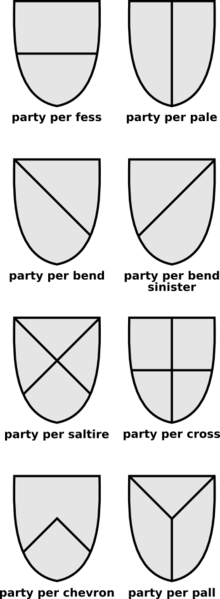

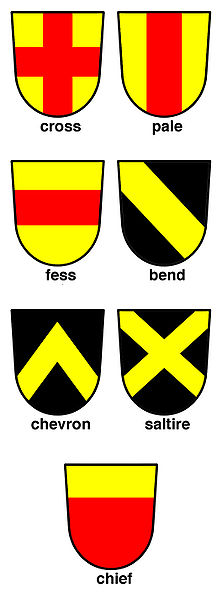
Figure 1: Divisions of the field
Figure 2: Heraldic tinctures
Figure 3: The most common ordinaries
Ierendi is a city-state, formally organised as a diarchy -- the joint rule of a King and Queen -- but actually run as an oligarchic republic -- the collective rule of a council of aristocrats, known as the Tribunal of Ierendi. The personal prestige of the famous adventurers who win the yearly appointment as King and Queen contributes to maintain the atmosphere of the city, a peculiar style that is flamboyant yet casual, which is designed to appeal to rich foreigners as well as to the local populace, and to divert attention from the real government engine. Besides the Tribunal, the other powers behind the throne are the mysterious fire mages of Honor Island, who act in Ierendi through a plenipotentiary, and the military. The Kingdom of Undersea also exerts a major influence, especially through the navy and the merchant and privateer families1.
The Royals of Ierendi hold merely ceremonial titles, conferred yearly as the result of the Great Tournament. Any authority they exert is based on personal influence, charisma and money, not derived from the law, as any laws proposed by the Royals need to be approved by the Tribunal in order to become effective.
The King and Queen, however, have some privileges, in particular in the appointment of some officials, the Ministers. They also select the Kia'i, or Guardians of Ierendi. It is worth noting that particularly savvy Kings or Queens may remain in charge for long periods, and end up exerting significant influence over the government thanks to their popularity. King and Queen are simply two offices, and do not imply any personal relation between the two -- actually, it is quite common for both the King and Queen to have families.
Eight ministers (four Ministers of the King and four Ministers of the Queen) complete the Royal Court. Ministers are basically agents at the direct service of the King and Queen. Contrary to ministers of other nations, they have no role in the executive, and act more as diplomats and advisors. They also help the King and Queen in their public role, and may replace them on occasion -- e.g., when an official is needed to make a speech on one of the lesser islands, a Minister might be sent instead of the King or Queen.
The Tribunal of Ierendi, formerly known as the Council of Lords, is composed of 21 members from the most powerful aristocratic families. These positions are formally elective, but de facto hereditary -- only should a family not be able to fill the Tribunal position, then the Council of Citizen would select a new family to take its place. All Tribunes are, formally, named by the King and Queen through a joint decree.
The Tribunal holds the executive and judiciary powers, exerting the former through the Council of the Sages and the latter through the Guard2. Moreover, the Tribunal must confirm all laws, which makes it the holder of the true legislative power -- in essence, the Tribunal is the true ruler of Ierendi.
The Tribunal often appoints Colleges3, that is smaller groups of Tribunes who are in charge of handling urgent problems, study and draft laws on a given issue, or otherwise act in place of the entire Tribunal with greater speed than allowed by the full assembly. A College has at least three members, and rarely more than seven -- since any more would make the College little different from the Tribunal itself.
The Tribunal is presided by the Chancellor of the Tribunal, elected yearly by the Tribunes.
A family that is selected to join the Tribunal receives the Baronial title. Individual Tribunes may not have the Baron title, but in general this only happens when the current Baron is old, and is replaced by his heir on the Tribunal. In most other cases, Tribunes are also Barons. However, the number of Barons is not fixed -- there are more Barons than Tribunes. This is because some families never were on the Tribunal, but were awarded a Baronial title by the Kings (this is formally still the case, but nowadays Baronial titles are only issued by the King and Queen, while the decision to award such titles is taken by the Tribunal), while at the same time some Baronial families lost their position on the Tribunal, but not their title.
The identity of the Tribunes, while not exactly secret, is not entirely public either -- the Tribunes avoid flaunting their status, and are rarely seen in public occasions. Like most Ierendi nobles, they prefer to keep their privacy well-protected by curtained sedan chairs and walled mansions. Sessions of the Tribunal are not public either.
The five Sages enact the decisions of the Tribunal, thus acting as an administrative (and partially an executive) body. Each Sage heads a Department (or, more properly, Magistrate) -- Agriculture, Foreign Affairs, Customs and Assessment, Internal Affairs, Military Affairs.
Proveditors are named to oversee the administration of regions (usually one per each lesser island, part of the Department of Internal Affairs) or specific matters within the scope of each Department. Lesser officers of each Department are called Subproveditors and Deputies. Within the Department of Military Affairs, these titles are reserved for civilian officers, while military officers are part of a different hierarchy, headed by the Admiral of the Fleet.
The Sages are chosen by the Tribunal. They may be Tribunes themselves, but this is not necessary -- they may as well be high-ranking career civil servants (i.e., former Proveditors). They customarily take part in the meetings of the Tribunal, but have no voting rights unless they hold both the Sage and Tribune position.
The Council of Citizens is formed by the heads of the largest merchant and land-owning families of Ierendi. About 10% of the families living in the city of Ierendi are represented on the Council, which has about 120 members (plus the Tribunes, who are also members of the Council of Citizens).
The Council elects new members of the Tribunal, though an actual choice is only given when the family of the previous holder cannot provide a candidate. The Council of Citizens may propose laws, which need to be approved by the Tribunal to become effective. A favourable vote from the Council of Citizens is also needed to modify laws that deal with the election of King and Queen, as well as the composition of the Tribunal.
The Council of Citizens is presided by one of its members, the Grand Chancellor, who also heads the office (Royal Chancery) that acts as the archives of the Tribunal and the Council of Citizens.
Members of the Council of Citizens use the Honourable style, unless they have a higher title (Baron or, more rarely, Kia'i). The Grand Chancellor uses the style Lord, regardless of his original rank.
Ierendian law recognises a single hereditary title, that of Baron. The title does not include land per se (Ierendi is not a feudal state), but is often associated with a position on the Tribunal. A Baron's wife becomes a Baroness (and vice versa), and both use the style Lord or Lady -- e.g. Lord Derwin Eddington (or Baron Eddington). His heir can use the style of Lord or Lady, though he does not have the right to seat on the Council (unless the Baron relinquished his own seat to him). Younger children of a Baron are styled "Honourable".
In modern times, a Baron who also has a seat on the Tribunal also appends "Tribune of Ierendi" to his name, and can be addressed as such. E.g., Baron Eddington's full style would be Lord Derwin Eddington III, Baron Eddington, Tribune of Ierendi.
Barons who do not hold a Tribune position have few benefits out of their rank, although they are recognized as equals in the Ierendi aristocratic milieu and enjoy the right to be judged directly by the Tribunal if accused of a crime -- a privilege that is rarely exercised, since it is seen as bad form to involve the Tribunal in “lesser matters”. Bribing the Guard is the accepted way to deal with any accusation.
King and Queen are the highest non-hereditary titles. These titles are temporary, lasting for a term of one year unless the current King or Queen manages to confirm his position in the annual tournament. Former Kings or Queens are entitled to a knightly position (see Kia'i). Children and spouses of Kings and Queens are styled "Honourable".
Kia'i (Guardian) is the most common non-hereditary title, awarded to famous adventurers. It is not permanent -- the Guardian must keep accepting "challenges" for the privilege of retaining his title. The Kia'i title is used for both men and women equally. The style "Sir" or "Dame" is also used by Guardians.
The nobles are ranked formally in the following order of precedence: King and Queen (equally ranked); Tribune; Baron; Guardian. Courtesy titles rank below the actual nobility titles, in the following order: Lord; Honourable. Note that the Grand Chancellor has precedence over all other Lords, while the Admiral of the Fleet is sometimes also a Ki’ai, but if he is not one, then he ranks immediately after the Grand Chancellor. All others holding equal ranks are sorted in order of seniority in the Tribunal, Council of Citizens, or in the Adventurers’ Club.
Visiting heads of states from foreign nations are generally ranked immediately below the King and Queen, while foreign noblemen are considered intermediate in status between Tribune and Baron (for landed titles) or Baron and Kia’i (for Knightly titles).
|
Ierendi noble or honorific title |
Nearest continental title |
|
King/Queen |
King/Queen |
|
Tribune |
Duke |
|
Baron |
Baron |
|
Kia’i/Guardian |
Knight |
|
Lord |
Court Lord |
|
Honorable |
Court Lord |
Heraldry on Wikipedia, http://en.wikipedia.org/wiki/Portal:Heraldry
“Heraldry Made Easy”, in Mystara Player’s Survival Kit, TSR, Feb. 1995
Bruce Heard, Known World Grimoire: Magical Heraldry, Dragon Magazine #199
|
|
|
|
|
Figure 1: Divisions of the field |
Figure 2: Heraldic tinctures |
Figure 3: The most common ordinaries |
Coats of arms are issued by the Council of Citizens and registered at the Royal Chancery. Technically, any family head can request a coat of arms, but only the affluent (i.e., those who are eligible to join the Council of Citizens) do so, due to the associated administrative costs.
Family coats of arms are used by all members of a family, each of whom generally adds some distinctive element to the basic arms to avoid confusion. Bordures4 and common charges (particularly mullets, crescents and roundels5) are often used to distinguish members of the same family. There is no specific rule, however, and each family has its own way to manage this issue, with a single, albeit important, exception.
The head of a noble (or rich) family always bears the basic arms, with a bordure to identify his title (if any). For the King and Queen, it is a bordure ermine. For a Baron or Tribune, it is a bordure erminois, with two exceptions: in the case of the Baron Matrongle, the bordure is pean (this exception is due to the original status of the Matrongle clan as the hereditary royal family of Ierendi), while in the case of the Baron Meikros, the bordure erminois is replaced by a bordure gyronny azure ermined argent and argent ermined azure (this exception is due to the fact that the Meikros coat of arms includes a bordure gyronny in its basic form).

Coat of Arms of the Baron Meikros, showing the peculiar ermined bordure
Finally, a member of the Council of Citizens adds a bordure vair to his or her coat of arms, although some exceptions exist for those families whose coat of arms already includes a bordure. On the other hand, the ermine, erminois, pean and vair tinctures are reserved for members of the royalty, Tribunal and Council of Citizens, so they never appear in other Ierendi coats of arms. The heraldic stains (tenné, sanguine and murrey), which in Thyatian and Darokinian heraldry are rarely used, except as punishment, are often used in Ierendi arms -- possibly because many Ierendi families descend from traitors and other criminals6.
Another reserved element is the goutte7, which can only be used by a Ki’ai (although not all Guardians choose to bear one in their coat of arms. The goutte des larmes is the most commonly used, except on colour fields, where the goutte d’eau is used instead. Eccentric Ki’ai also use other gouttes, and some prefer to change the field from the original tincture to a gutty variation. The only exception is the goutte de poix, which is used traditionally by the Caulker family.

The arms of Baron Derwin Eddington, Tribune of Ierendi, showing the bordure erminois signifying his tribunal rank.
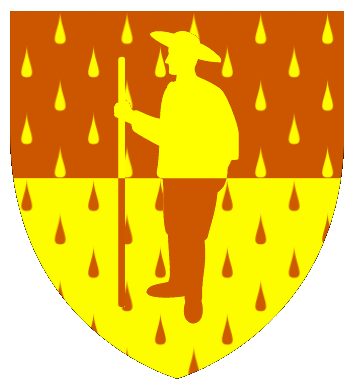
The arms of Kia’i Figgen Halffellow, showing a goutty field, which symbolizes the large number of participations to the Royal Tournament.
Most of the noble families of Ierendi are of human stock. These people are only in part descended from the original founders -- relative newcomers include the Thyatian exiles that formed Mad Creeg's entourage and descendants of the great captains of the pirating days of Ierendi.
Nobles of Halfling descent can generally trace their ancestry to one of the "Four Hin Exiles", Durmast Caulker, Tolman Halffellow, Holvar Longkeel and Archer Shanwood.
There were very few Elves (five, according to the legends) among the original inmates of the Ierendi prison, and most Ierendian with elven blood are likely descended from one of them, or from visiting elven adventurers. A few noble families (the Alvine, Elfinblood, Gentle and Halfelven) are considered "half-elven" -- in each generation, these families produce one or two offsprings that favour heavily their elven ancestry, and most other members of the family have some elven traits (pointed ears, delicate facial features, etc.).
Even though dwarves were present among the first prisoners, there is no great or noble dwarven family. Actually, very few dwarves are found in Ierendi at all, and most of them seem to be recent immigrants. What happened to the native dwarves is one of the Ierendian mysteries -- all traces of dwarven families stop about two centuries ago. Rumors abound of lost dwarven settlements near mount Bina-Bura on Ierendi island or in the higher parts of Alcove island. Also, Thyatian scholar Manuelus Nicholous, in a note to his magnum opus, The Senator, hints at the connection between the disappearance of the dwarves from Ierendi and the contemporary persecution of dwarves in Glantri, noting that Glantri has often exerted some direct or indirect influence on the island kingdom since the times of Kerhy Matrongle.
Matrongle Dynasty8
Mad Creeg 602-637 Founder of the Kingdom of Ierendi.
Black Toes & Kerhy Matrongle 637-663 Son and daughter-in-law of Mad Creeg.
Kerhy Matrongle 663-670 Kerhy survived her husband.
Jan Matrongle 670-684 Son of Black Toes and Kerhy. Died at sea at 46.
Halia Matrongle 684-701 Daughter of Black Toes and Kerhy, sister of Jan.
Michelozzo Matrongle 701-718 Son of Jan.
Donatello “The Black” Matrongle 718-735 Son of Michelozzo. Disappeared at sea.
The Forty Years Terror9
Artalus “Art” Rackham 736-748 Elected by the Council of Lords. Died at sea at 50.
Thaddeus “Fish-eye” Teach 748-762 Elected by the Council of Lords.
Varaldo “Aldo” Teach 762-769 Son of Thaddeus. Died in a fire at 57.
Willem Van Hoorn 769-775 Elected by the Council of Lords. Assassinated at 39.
Elective Kings/Queens10
Rena Longkeel 775-787 Elected by the Council of Citizen. Abdicated.
Derwin Eddington 787-790 Elected by the Council of Citizen. Deposed.
Elective Kings & Queens11 790-867
Tournament Kings & Queens 868-current
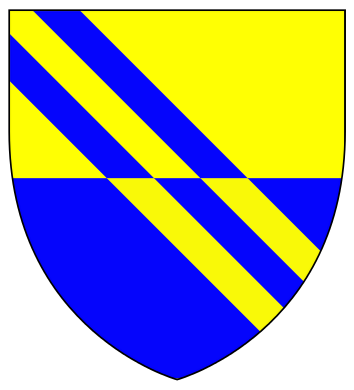
The Alexander family descends from former Senator Tiberius Alexander, a political opponent of Thyatian Emperor Lucius IV Monomachos, imprisoned in the penal colony of Ierendi in 596 AC. Tiberius had been the leader of a small but rich senatorial family from Kerendas, and an experienced politician and military man, having campaigned as a cavalry officer in the Isle of Dawn. With his prospects in Thyatis ruined, he fell in with the Hattian pirate, Mad Creeg, and was instrumental in organizing the Royal Brigade and the Ierendi fleet, adapting Thyatian military science to the conditions of the archipelago. His descendants turned to piracy and smuggling, and finally legitimate trade. The current Baroness, Kel Alexander, favors Darokin over the Shires in foreign policy, reasoning that Darokin is more complementary to the strengths of Ierendi.
Coat of Arms: Per fess or and azure, two bendlets countercharged.
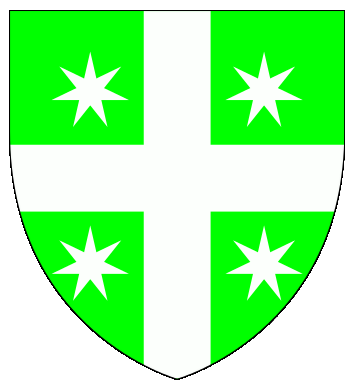
The Alvine were originally an elven family, composed of two of the original elven prisoners and their descendants. They settled in Port Siers, and both family leaders died in the eruption that destroyed that town. Their descendants married into the human families of Ierendi, so that nowadays the Alvine are not much more elven than the Gentle or the Elfinblood. Having lost their plantations in the Port Siers catastrophe, the Alvine turned to mercantile trade, developing good trade contacts in Port Tenobar and Minrothad. They are well connected to the Darokinian House Umbarth, with whom they also have blood ties.
The Alvine have, for undisclosed reasons (reputed to have much to do with the way the clan founders ended up in Ierendi), a long-lasting hatred towards the Five Shires, and a general mistrust of the hin folk. Thus, politically they strongly favor Darokin both as a trade partner and a political ally of Ierendi. The current Baroness, Mira Alvine, is a tall, dark haired woman about thirty years old, with elven ears and eyes. Gossipers at the Adventurers’ Club firmly believe she is looking for a mate in the Karibus clan -- or perhaps the Meikros clan.
Coat of Arms: vert, a saltire between four mullets of seven argent.

The Caulker family claims to descend from Durmast Caulker, one of the first exiles, who had been abandoned on a raft for unspecified crimes. The legend is hard to believe, as all four of the first hin exiles were males, but what is historically certain is that the Caulkers were already settled in Ierendi when the Thyatians occupied the archipelago. Rather than flee to the mainland, as many other hin did, the Caulkers and the Longkeel, another ancient clan of halflings, retreated into the swamplands, fighting a long guerrilla war against the Thyatian legionnaires.
They would have never dislodged the occupiers, had it not been for the large number of political prisoners brought to the archipelago by the Thyatians. When a captured Caulker met Mad Creeg, the deal that would free Ierendi from the Thyatian occupation was struck. The Caulkers and Longkeels coordinated a raid against the prison camps with an uprising of the prisoners, and freed many of them, starting a large scale rebellion.
After the establishment of the Kingdom of Ierendi, the Caulkers turned eagerly to piracy, to which they commit to this day, under the pretence of “privateering”. Hal Caulker, a relatively young baron, leads the clan with a strong hand, and has gathered a reputation of recklessness.
Coat of Arms: quarterly tenné and or, on each quarter a lymphad sable.
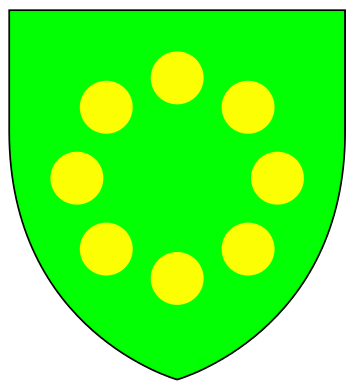
The Eddington family has its roots in the Eastwind clans of Streel Plains of Darokin. In the III century BC, the Eastwind chief Eadwine son of Eadbald led his clan to victory against the orc tribes in the Second Battle of Favaro. His descendants founded the village of Eadwintune in the northern reaches of Eastmark. Two centuries later, Edmun of Edington, a captain in Ansel Eastwind's campaign against the southern Eastwinds of clan Ansimont, earned the title of Earl of Edington. By the VI century AC, the Eddingtons had the title of Barons, following a reorganization of Darokinian noble titles, and were vassals to the newly independent Duke of Dirnath. Baron Arlin Eddington, however, was a partisan of the Sorcerer Princess Lowetha of Dirnath, who murdered her father, Duke Iolan, plunging Dirnath into chaos. By the end of the century, the Eddingtons were displaced to southern Darokin, and the village of Eddington was an abandoned ruin.
In 688 AC, Derwin Eddington left the crumbling Kingdom of Darokin with his family and a single ship. He launched into sea trade, hoping to exploit the new trade routes from Ierendi to Sind. His trade ventures were not terribly successful, and his heirs turned to piracy and settled in Ierendi. One of them, Edward "the Black" Eddington, was hanged for piracy in Port Lucinius in 703 AC, while Arthur "Longtail" Eddington crowned a successful, decade-long piratical career in the western seas by buying the title of Baron from crown of Ierendi in 754 AC. The fortunes of the family raised quickly. Arthur’s son, Edward, was elected to the Council of Lords in 765 AC and his grandson Derwin was elected King of Ierendi in 787 AC. However, his reign was brief -- the Age of the Pirate Kings was over, and the mercantile class ousted King Derwin just three years after his crowning, and forced the formation of the Council of Citizens.
The Eddington family remained part of the Tribunal, however, and is still one of the most powerful houses to sponsor privateers. The leader, Derwin III, is in his seventies, but still hale. Many sons, grandsons and other relatives tend to the day to day business, which ranges from merchant trade to privateering.
Coat of Arms: vert, eight bezants in annulo.

The Elfinblood family descends from Ellantir, a Callarii adventurer who is often counted among the first settlers of the islands of Ierendi. Certainly, Ellantir had settled on Elegy Island when the Thyatians seized the archipelago from the hin, and remained there for thirty more years, when his human wife died. At that time, Ellantir’s children were already middle-aged, whereas the elf was still young. Between the shock of his wife’s death, and the difficulty of living in a world where everyone aged much faster than him, Ellantir took advantage of the new influx of ships -- smugglers and pirates attracted by Mad Creeg’s new nation -- to leave Elegy and the archipelago. Nothing more is known of him -- perhaps he returned to the Radlebb woods, although by this time even he would be fairly old, or perhaps he died in some boarding action on the high seas.
In any case, his descendants, marked by a longer lifespan than the average human and by somewhat elfin features on otherwise Makai build and complexion, remained on Elegy for decades, until Ellantir’s granddaughter, Jek, joined a hin pirate crew, got rich, and finally settled in Ierendi city, establishing first a tavern, and later a shipwright business. Her descendants constantly expanded the family assets, diversifying into trade and buying a noble title from the last Matrongle king. The current Baron, Keril Elfinblood, shows strongly his elven heritage -- while he is reaching his sixth decade, he is still as youthful as if he was in his thirties, and is a good mage (for Ierendi) as well as a decent swordsman. A no-nonsense politician, he keeps the family mostly neutral, although he generally sides with the New Money and the philo-Darokinian factions if he needs to.
Coat of Arms: argent, a basswood vert.
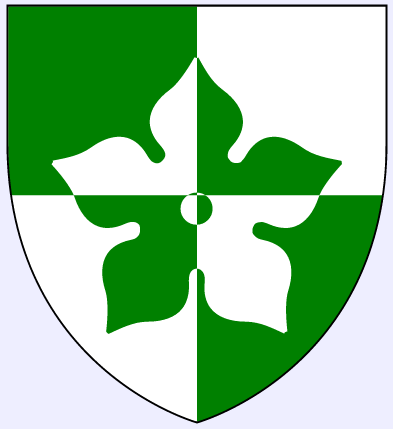
This is one clan whose history is shrouded in myth. Very little is known about the origins of the family, which does not trace its origin to any of the first exiles, yet it is as ancient as the Caulkers or the Longkeels. In any case, the Gentles carry elven blood, and occasionally a child is born with a natural affinity for magic, pointed ears, or infravision. At the time of the rebellion, the Gentles owned (and had operated for since the hins’ times) a trading post on Ierendi Island, as well as a small, independent plantation. While they remained neutral in the conflict between the rebels and the Empire of Thyatis, they managed to acquire large amounts of land in the first years of Mad Creeg’s rule by acting as go-betweens towards Five Shires weapon dealers, as well as providing advance money to cover the construction of the King’s fleet.
Since that time, the family focused entirely on the business of running plantations, becoming the breadbasket of the City of Ierendi, as well as a provider of exotic fruit to several Known World markets. Politically, the Gentle Barons are generally conservatives, and support a closer alliance with the Five Shires, which are one of their primary markets.
Coat of Arms: quarterly vert and argent, a cinquefoil countercharged.

The Traladaran clan Gogunov originated in the Duchy of Marilenev, where they were a trading family closely allied with the Dukes. After the Guilds ousted the Marilenev family from power, the Gogunov, threatened by the aggressive Radu clan, moved to Lazkow, a small trading and fishing town along the coast south of Marilenev, where they thrived for three centuries, establishing good trading relations with the islands of the Sea of Dread. When the Thyatian armies led by Flavian Oesteropoulos landed in Marilenev, the Gogunov attempted to put up a resistance, but were easily defeated. Several family members fled to Ierendi, where they had warehouses and offices, moving their trading base there. The family completely abandoned Traladara after the Marilenev Rebellion against the newly-installed Duke Stefan Karameikos. By that time, the Ierendi branch of the family had become one of the richest clans in Ierendi, and bought a position at the Tribunal when the Vane family was ousted for piracy against Ierendi ships.
In Ierendi, the Gogunov are strongly in favor of an alliance with Darokin, both against Thyatis and for commercial reasons. They have little land in Ierendi, and most of their wealth is invested in trade ventures. This, combined with their recent joining the Tribunal, makes it so that they are not much trusted by the landowning clans.
Coat of Arms: per pale gules and sable, a lion rampant argent.
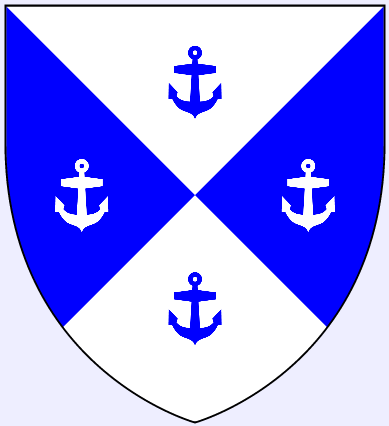
The Halfelven family is a relative newcomer to the Ierendi aristocracy. The family descends from the popular Queen Haradith of the Tall Cedars, who was known as a “half elf”, being the illegitimate daughter of an Erewan elf and an Alphatian lady from Glantri City. Thanks to her twelve years as the Queen, Haradith amassed not only popular favor, but also a large network of contacts, which she was able to use to establish a number of trading ventures, including the first resorts for rich adventurers. She was awarded a baronial title after retiring from the royal competition. Her descendants continue in the family business, and soon bought their way into the Tribunal. The current Baron Halfelven is, actually, not that elven -- actually, gossipers call him “Halfdwarven”, for he is short, fat and greedy as a dwarf. Politically, he favors progressive policies that increase mercantile trade.
Coat of Arms: per saltire azure and argent, on each an anchor countercharged.

The Halffellow family is one of the oldest land-owning clans in Ierendi, dating back to the times of the Hin settlement of the islands. The family claims to descend from Tolman Halffellow, one of the “four exiles”, the first four Hin who were exiled to Ierendi. Historically, the clan was already established in the interior of Ierendi when the Thyatians took over. The Halffellow clan leaders supported Mad Creeg’s rebellion, and further extended their lands in the formative years of the Ierendi monarchy.
Today, the family is still quite large, with several members managing farms scattered on the main island. The Baron Halffellow is a conservative politician who favors the Five Shires over Darokin in foreign affairs. Beyond the Baron, the most prominent member of the family is Ki’ai Figgen Halffellow, a well-known adventurer who lives in the city of Ierendi.
Coat of Arms: per fess tenné and or, a shepherd countercharged.

The Karibus family originated in Thyatis. Contrary to many other inmates of the penal colony in Ierendi Island, Eusebes Karibus was truly a criminal, of the “white collar” kind -- convicted for numerous charges of war profiteering, tax evasion and fraud. When Mad Creeg organized his rebellion, Eusebes offered his services -- he knew well most of the corrupt Thyatian officials in the colony, and had smuggled into the colony a small fortune in gems. When the Kingdom of Ierendi was established, Karibus went back into business, primarily by re-opening the brothels that had served the Thyatian troops for the new customers, the local and foreign pirates. The business perfectly fit Karibus and his descendants, and much of the stolen wealth of the pirates ended up in their coffers. It is not unsurprising that the Karibus were able to enter the Council of Lords quite early, during the reign of Michelozzo Matrongle.
Nowadays, the Karibus business is, officially, mostly shipping and touristic resorts. In truth, the family business has not changed much from the times of the Pirate Kings. Politically, the Karibus are in favour of opening Ierendi to the foreigners, especially if the foreigners are rich and willing to part with their wealth.
Coat of Arms: vert a baton or.
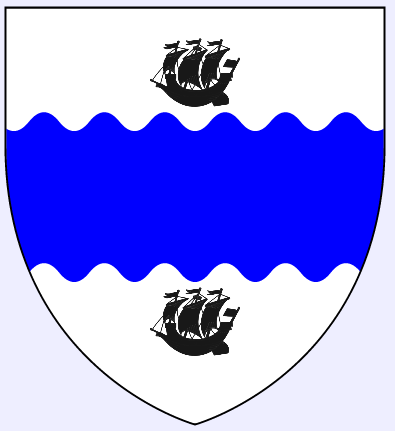
The Longkeel family descends from one of the Four Hin Exiles, but only rose to fame during the Age of the Pirate Kings. The Longkeel were not part of the original Council of Lords, but worked their way through the ranks through bloodthirstiness and courage. Although few Longkeel captains remain in Ierendi history, the family produced many quartermasters, who were generally very popular with the crews. The most famous Longkeel remains Queen Rena, who was so popular that the Council of Lords, forced by the merchants and the lower classes to concede elections for the succession to King Willem, negotiated her candidature, which was highly successful, and stymied the protests against the Council’s harsh rule for a decade.
Rena, knowing she was not in the position to overthrow the Council, chose to side with it, bargaining the admission of her family into the Council for her abdication, and support for an aristocratic candidate, Derwin Eddington. The Longkeel have since positioned themselves comfortably in the Ierendi aristocracy, adopting all their customs and mannerisms. Nowadays, the family operates several privateer ships, as well as a few merchantmen.
Coat of Arms: argent, a fess wavy azure between two ships sable.
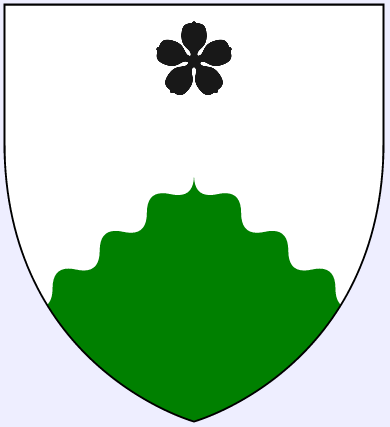
The Marley clan is one of the few Ierendi families with roots in Minrothad. Cooper Marley was one of the rebel chiefs, and one of the retired pirate captains that went on to form the Council of Lords that advised King Black Toes. His descendants were remarkably less successful, but managed to cling to power, until Geral Marley had a strike of luck -- a recent immigrant from the Guilds, whom Geral had hosted out of a whim, turned into a successful prophet and founded the People’s Temple of Ierendi, a major (and lucrative) religion. Geral became one of the Temple officials, considerably improving the family fortunes.
Nowadays, the Marley still remain in the privateering business, although many of them are employed either as Temple officials or as naval officers.
Coat of Arms: per chevron wavy argent and vert, a cinquefoil sable in chief.
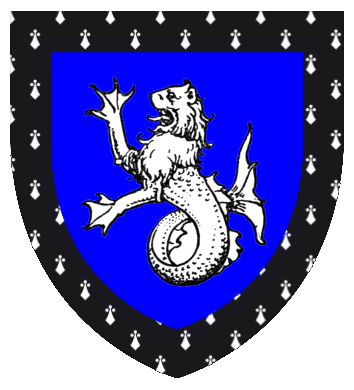
The Matrongle family descends more or less directly from Kerhy Matrongle and Black Toes, Mad Creeg's son and the second King of Ierendi, who took his wife’s surname. Mad Creeg himself was a Hattian and a political opponent of the Thyatian emperor of that time, Lucius IV Monomachos. He had turned to piracy as a way to oppose the emperor, shedding his true name and taking the moniker of Mad Creeg. Captured by a Thyatian patrol off the southern coast of Hattias, he and his surviving crew had been deported to Ierendi. After the successful rebellion, he had married a local woman. Of Kerhy Matrongle little is known, except that she hailed from the Flaem Highlands and was a reasonably competent mage of clearly Flaem ancestry.
The Matrongle dynasty, in any case, produced a number of Pirate Kings, until the disappearance of Donatello “The Black” - who did not have any legitimate heir - in an expedition towards Davania weakened the family to the point that the Council of Lords ousted them and elected a new Pirate King from the Rackham family. The surviving Matrongle took years to emerge from a bloody feud, jokingly called the “Matrongle Succession War” by the other families. In time, they regained their position on the Council of Lords, but the mercantile and naval assets of the family had been compromised by Donatello’s ill-fated expedition, as well as by the internal struggles. Nowadays, the Matrongle are a primarily landowning family. Due to their history, each branch of the Matrongle family tends to concentrate control of the family possessions into the hands of a single heir. The Baronial branch of the family is led by Faral Matrongle, a greedy, fat man who deals mostly with hin merchants from the Five Shires, who buy his plantations’ produce wholesale.
Coat of Arms: Azure a sea lion argent within a bordure ermines.
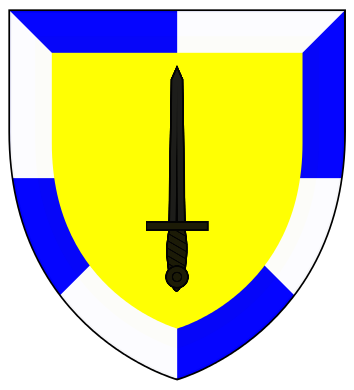
The Meikros family is one of the oldest in Ierendi, dating back to the Thyatian penal colony back in the late VI century. The founder, Galerian Meikros, was an impoverished noble who had turned to smuggling and had been falsely involved in a plot against the tyrannical Emperor, Lucius IV Monomachos. After serving a 10 year sentence on the islands, Galerian was unable to return to Thyatis (Lucius’ laws exiled minor conspirators), and established a small plantation in the island of Ierendi and married a local woman.
Galerian’s son was quick to throw his lot with the pirate captain, Mad Creeg, in the rebellion that led to the formation of the Kingdom of Ierendi. Galerian’s descendants were involved in early piracy, but they mostly took advantage of the pirates’ lack of agricultural skills (and interest) to expand their plantation, selling their products high and acquiring slaves at very low prices. When the state consolidated along more civilized lines under Kerhy Matrongle’s descendants, the Meikros emerged as one of the most powerful and rich families, and were inducted in the aristocracy with a baronial title.
Currently, Baron Meikros is one of the most senior members of the Tribunal, and a well respected one as well. His son, Midges Meikros, holds divisional commander commission in the Ierendi Royal Brigade, the élite ground force of the Kingdom.
Coat of Arms: or a sword sable within a bordure gyronny azure and argent.
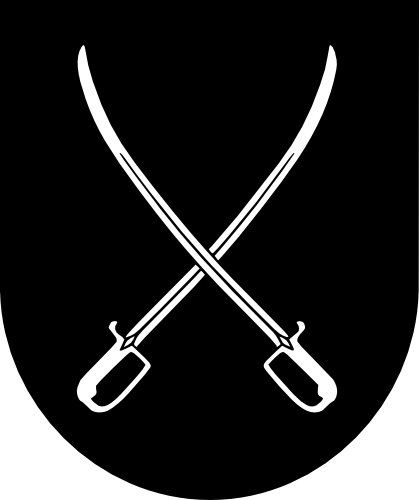
This family holds the distinction of having provided the first king of Ierendi outside the Matrongle clan. The founder, Cormac Rackham, was a Darokinian exile who had taken to piracy in the VIII century. His son, Artalus Rackham, was the hero of the Battle of Jaibul, where the Sindhi navy was destroyed by a pirate fleet secretly funded by Ierendi and Minrothad. When Donatello Matrongle was lost at sea in 735 AC, the Council of Lords overrode the Matrongle claimants -- all of them only distantly related to Donatello -- and named the popular “Art” king. Art Rackham not only openly sanctioned piracy against foreign merchant navies, but contracted the fleet and the Royal Brigades as mercenary units. He did bring a time of prosperity and change to Ierendi, leading to the exploration and settlement of several of the lesser islands. However, in 748 AC, he died at sea, after an unforeseen storm took his fleet. Rumors abound that his death was engineered by the Sea People, who did not like the aggressive policy of exploration and exploitation of marine resources that King Art had been pushing for. Indeed, the Council of Lords quickly selected a new king from the Teach family, which was well known to have close deals with the merrow, ending the reign of the Rackham kings.
The Rackham family remains one of the more aggressive group of privateers. They also sponsor several marinas, owned by Hanni, a cousin of the current Baron Rackham.
Coat of Arms: sable, two crossed scimitars argent.
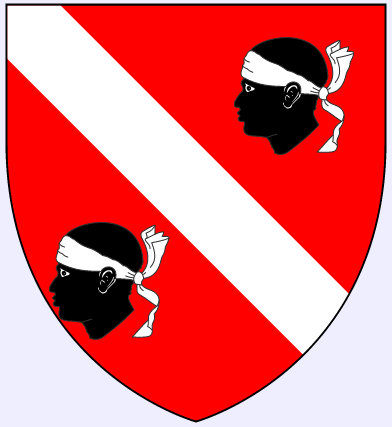
The Rogers family is the newest entrant in the Tribunal, having joined it when the Council of Lords changed its name in 980. The accession of the Rogers was a political move to give the impression of real change, as the Rogers were recent immigrants from Darokin. However, little real change happened, as the newcomers had well-established trade relations with several of the Lords, and were even related by marriage to the Eddington and Van Hoorn families. The Rogers had left Darokin mostly to escape taxation, and employed much of the saved wealth in campaigning for their leader’s “election” to the Tribunal.
Nowadays, the Rogers are mostly aligned with other mercantile families, and are a force for modernization in Ierendi, having brought several best practices over from their homeland.
Coat of Arms: gules a bend argent between two moor’s heads.
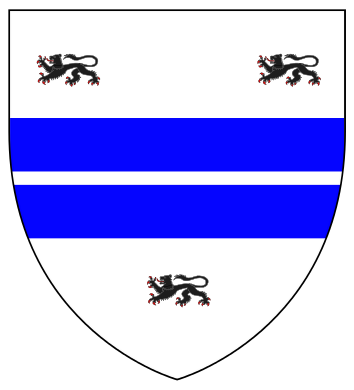
The Seilus family arrived in Ierendi during the Pirate Kings era. With a piratical tradition of its own, the first Seilus were forced to flee from Thyatis after a “misunderstanding” with the Shadow Hand, the powerful Thyatian thieves’ guild. At first dabbling in piracy and smuggling, the Seilus went legitimate at the end of the Pirate King era, establishing strong ties with the Achelos trade firms. Nowadays, they are one of the richest merchant families, as well as one of the most politically savvy. Baron Seilus, a long-bearded, elderly statesman, is the current Chancellor of the Tribunal, and therefore the holder of the executive power in Ierendi.
Coat of Arms: argent two bars azure between three lions passant sable.
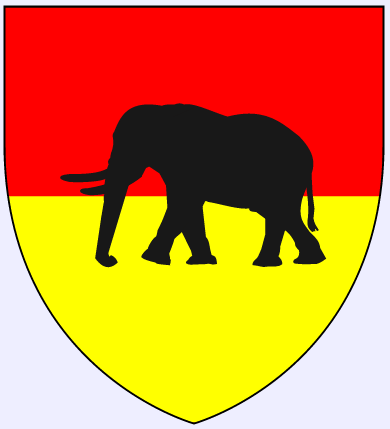
The Seleukides family is of Kerendan origins, although it is first attested in the Thyatian province of Dythestenia, nowadays a part of the Emirates of Ylaruam. A branch of the family purchased lands in the archipelago from the Thyatian government shortly after the occupation, and established a set of plantations. While most plantation owners were forced to leave during the rebellion, the Seleukides family did not make use of prisoners as indentured servants, and thus was not a primary target for the rebels. The family leaders of the time negotiated with Mad Creeg, offering much needed supplies in return for safety. Once the Kingdom of Ierendi was established, the Seleukides kept a low profile, so they joined the Council of Lords only later, after the end of the Age of the Pirate Kings.
The current Baroness, Apama Seleukides, is a middle aged woman who controls vast plantations. She is very prudent and conservative as a politician, favoring the more reliable Darokinians over the flamboyant hin of the Five Shires. Like most of her ancestors, she favors an unofficial policy of division between the Ierendians of continental origins and the various native tribes.
Coat of Arms: per fess gules and argent, an elephant sable.
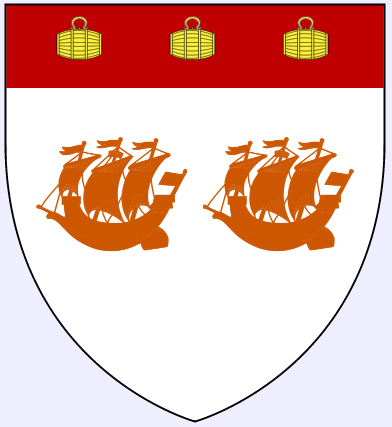
Archer Shanwood, the founder of the Shanwood Hin clan, was one of the First Prisoners, the Hins exiled to the Ierendi archipelago. Contrary to the other famous Hin families, though, the clan did not rise to prominence early on, as many of its members returned to the Five Shires during or after the Thyatian occupation.
During the Age of the Pirate Kings, though, the Shanwoods, who had become successful pirates operating out of Rundegos, came back to Ierendi, which was a market to their stolen goods as well as an occasional port of call when the Five Shires ports were watched by the Imperial Navy.
“Pegleg” Thob Shanwood was perhaps the most successful of the Five Shire Shanwood pirates, and although his treasure was lost with his death at sea, the clan thrived both on the mainland and in the archipelago.
The current Shanwoods are still in the privateering business, and although on the Ierendi side their activities are significantly more within the boundaries of the law than on the Five Shires side, they are still considered pirates at heart. Baroness Shanwood, a tough old Hin lady, is considered the strongest ally of the Five Shires in Ierendi, which makes her a target for the attacks of many human Tribunes.
Coat of Arms: argent two ships tenné and on a chief sanguine three barrels or.
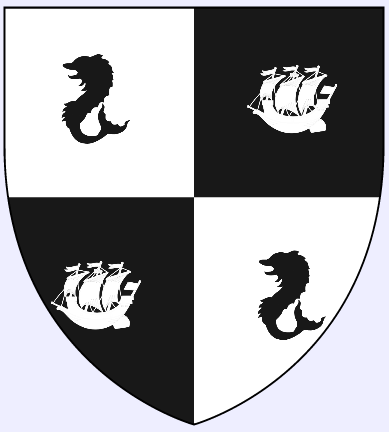
The Teach family used to dominate the Council of Lords during the later age of the Pirate Kings, after the death of Donatello Matrongle led to the “Matrongle Succession War” and the ousting of the royal family.
The family had been active in Ierendi since the founder, Marlon Teach, a Minrothaddan sailor, had been quartermaster on Claes Van Hoorn’s flagship, the Red Lightning, and his son had been inducted into the Council of Lords under the reign of Jan Matrongle. After the death at sea of Artalus Rackham, Thaddeus “Fish-eye” Teach, who was the leader of the faction within the Council opposed to Rackham, was named king. The circumstances of this election, and why neither Artalus’s daughter, Yolanda, nor any of his three nephews inherited the throne, are not entirely clear, as the Royal Chancery seems to be missing the records of that year. In any case, it amounted to little less than a coup d’état, and the Rackham and Teach families, while sharing similar interests, are not on the best of terms. Besides Thaddeus, another Teach, Thaddeus’ son Varaldo, ruled as King of Ierendi. The family fortunes grew considerably during that time, and have not faltered since that time, even though Varaldo and both of his sons died in an accidental fire that destroyed the original royal castle.
Nowadays, the Teach family provides the largest amount of privateer ships to the fleet, and owns also several large tuna fisheries.
Coat of Arms: per quarter, 1 and 4 argent a dolphin sable, 2 and 3 sable a ship argent.
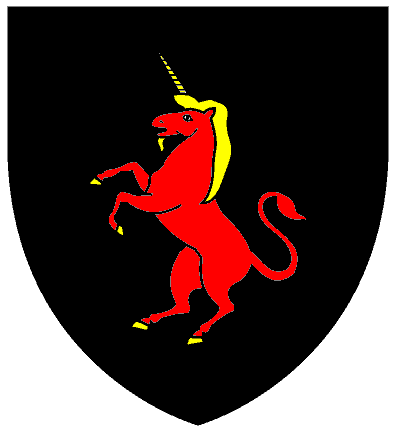
The Van Hoorn family descends from one of the leaders of the anti-Thyatian insurrection, Claes Van Hoorn, a Flaem heretic who had joined a Hin pirate crew and had been captured by the Thyatian fleet. While the early Van Hoorn were blood-thirsty pirates, including the only Van Hoorn king, Willem, the current leadership of the family thrives on mostly legitimate trade. The Van Hoorns are shipping magnates, their roundships moving huge amount of cargo to and from Athenos, Tenobar, Jahore, Specularum and Minrothad.
Coat of Arms: sable a unicorn gules armed, unguled and crined or.
Ierendi politics revolves around shifting allegiances between the families that sit on the Tribunal. There are generally two parties (a dominant one and an opposition), but when the current dominant faction suffers a major defeat, the new ruling party generally breaks into two different groups, the weaker of which usually tries to get support from the defeated families. Factions usually form along economic or political interests, but there is also a strong divide between the Old Aristocracy -- families who claim to descend from the first settlers and the leaders of the rebellion that led to the foundation of the Kingdom -- and the “New Money” families, merchants and privateers who immigrated more recently. In terms of economic policy, Landowners are generally at odds with Seafarers, both merchants and privateers. However, in foreign policy the issue is usually between a philo-Darokinian faction (mostly merchants who wish to improve trade relations with the rest of the Known World) and a philo-Hin faction (mostly composed by privateers who favor a strong alliance with the Five Shires against Thyatis and, to a lesser extent, Minrothad). The other two alliances -- with Honor Island and with Undersea -- are never seriously challenged, as they are the basis of Ierendi independence from the mainland powers.
Which criterion is used at any given time depends on the primary political issues that are discussed at the time, as well as economic and foreign policy factors. Table 1 classifies the current Tribunes along the three main criteria.
Table 1: Political factions in the Tribunal of Ierendi
|
|
Old Aristocracy |
New money |
|
Landowners: (pro-Darokin) |
Meikros, Seleukides, Karibus |
|
|
(pro-Shires) |
Gentle, Halffellow, Matrongle |
|
|
Merchants: (pro-Darokin) |
Alexander, Alvine, Van Hoorn |
Eddington, Elfinblood, Gogunov, Halfelven, Rogers, Seilus |
|
Privateers: (pro-Shires) |
Caulker, Longkeel, Marley |
Shanwood, Rackham, Teach |
Anne Gray McCready, Kingdom of Ierendi (Gazetteer 4), TSR 9215, 1987
John W. Biles, Alternate Ierendi Gazetteer: The Pirate Kingdom, http://pandius.com/AIGV1.pdf
Andrew Theisen, Timeline of the Sea of Dread, Threshold Magazine Issue 3, page XX
James Mishler, The Thanegioth Archipelago, http://www.pandius.com/thanegio.html
James Ruhland and Giulio Caroletti, Timeline of Thyatian History: The Middle Centuries, Tome of Mystara, vol. 3, http://www.pandius.com/tome/tomevol3/thyatis/thyatis4.html
Giulio Caroletti, Arentela, http://pandius.com/arentela.html
1 It is worth noting that the independence of Ierendi from Thyatis and other powers is ensured only by the military and intelligence help the Kingdom receives from Honour Island and Undersea.
2 The Guard has the authority to pass sentences, while the Tribunal acts mostly as a court of appeals. Only members of Baronial families or those that belong to the Council of Citizens can request a trial at the Tribunal without a sentence passed by the Guard. It is also worth noting that the Tribunal has little to no interest in fair trials -- most appeals are simply handled by confirming whatever sentence came from the Guard, with an added penalty to discourage other people from appealing the Guard’s judgements.
3 For example, in the War of the Master crisis, the Tribunal appoints a college composed of the Lords Seilus, Meikros and Karibus to deal with the events [See X10 “Red Arrow, Black Shield”]
4 A bordure is a thick border around the shield, painted in a different colour from the field.
5 A mullet is a (usually five pointed) star, a crescent is a rising moon shape, and a roundel is a disc shape.
6 However, note that the Tenné stain is almost only used by hin families, possibly as a replacement of the orange tincture which is present in the Five Shires arms, but not used in Ierendi heraldry.
7 A goutte is a stylized drop. A drop of tears (goutte des larmes) is painted azure, whereas a drop of water (goutte d’eau) is painted argent. The goutte de poix, or drop of tar, is painted sable.
8 Inheritance of the throne went through the Matrongle family, initially through seniority rather than primogeniture -- Halia Matrongle was Jan’s sister, for example. Her descendants are the current Matrongles, since Jan’s line became extinct with Donatello.
9 During this time, the king was selected by the Council of Lords.
10 During this time, the position of King (or Queen) became elective, theoretically through popular elections, although candidature were controlled by the Council of Lords. The position was for life, although Rena Longkeel abdicated and Derwin Eddington was ousted.
11 During this time, the positions of King and Queen were elective and lasted only one year, like in modern times. Candidatures were still very much controlled by the Council of Lords.
12 This is Respen ak Tarpis, introduced in the Gazetteer. An alternate view of Respen and his homeland can be found in Giulio Caroletti’s article, “Arentela”.